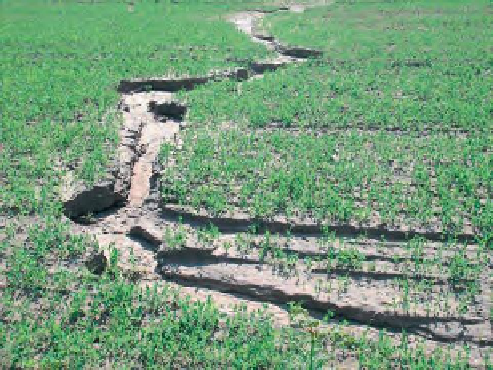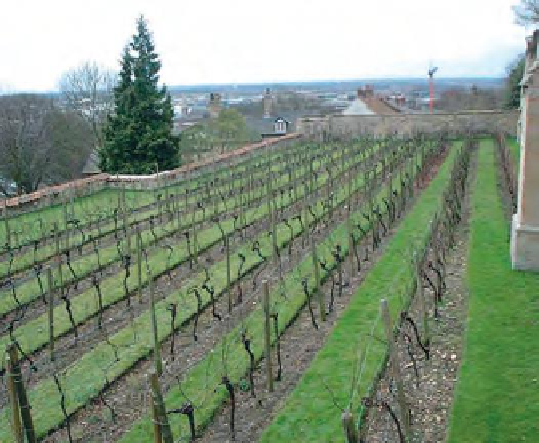Agriculture Reference
In-Depth Information
Soil water
The healthy growth of a plant requires a constant
supply of water, which is taken up through the roots
from the growing medium (see p. 121). Problems
occur if there is too little water for the plants so
watering (irrigation) becomes a consideration.
However, if there is too much water which stops us
working on the land or harms the plants, the possibility
of improving drainage should be considered.
12
Water infiltration
Most rain falling on the soil surface soaks in, but
if it exceeds the rate it can infiltrate, then water
accumulates on the surface. This
standing water
(also
known as 'ponding' or simply as puddles) leads to soil
capping because soil crumbs tend to collapse when
wet. Soil surfaces can be protected with mulches (see
p. 160) and become less vulnerable as they become
covered by plants. As the soil becomes
saturated
(full
of water, waterlogged), the standing water (puddles)
becomes more extensive and long lasting so damage
to soil structure at the surface increases.
Figure 12.12
Terracing is used to reduce 'run-off' and
to create fl at areas on slopes that are otherwise too
steep for cultivation
major problem worldwide and is commonly overcome
by the creation of terraces. There is less pressure to
do this in Britain and Ireland, but there are situations
where it is appropriate (Figure 12.12).
As water soaks into the dry soil, all the pore spaces
are filled with water, that is, they become saturated
(also known as 'waterlogged'). The roots in this
saturated zone can only obtain water from what is
dissolved in the water.
A
saturated
soil is one which has all the soil
pores filled with water.
On slopes there is
surface run-off
. Depending on the
steepness of the slope and the intensity of the rain,
soil can be carried away (erosion) along with seeds,
fertilizers and mulches (Figure 12.11). This is wasteful
for the gardener, but also it is bad for water courses
that receive the fertilizer. Growing on steep slopes is a
The
saturation point
of a soil is when water has
filled all the soil pores (i.e. no air in the pores).
Field capacity
When rainfall ceases, the water in the larger soil pores
continues to move downwards under the influence of
gravity. As
gravitational water
(sometimes referred
to as 'excess water') is removed, air returns in its
place bringing with it a fresh supply of oxygen. On
sandy soils this may take a matter of hours after the
rain has stopped, but far longer on clay where this
process may continue for many days. The soil is then
said to be at
field capacity
(FC).
Field capacity
is the amount of water the soil
can hold against the force of gravity.
Figure 12.11
Soil erosion is a result of water 'run-off';
the moving water carries particles downhill. The faster
the water moves, the more soil carried and larger 'rills'
are created eventually forming gullies
The amount of water held at field capacity is known
as the
water-holding capacity (WHC)
or moisture-
holding capacity (MHC) of the soil (Table 12.3). Most






